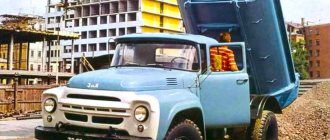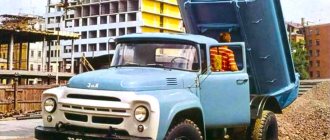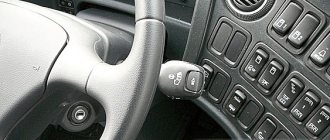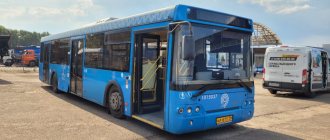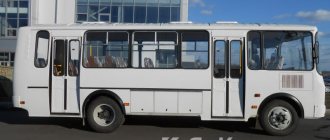Article published 07/04/2014 07:54 Last edited 01/02/2015 05:28
| Full title: | CJSC "Lvov Bus Plant" |
| Other names: | "Plant of Municipal Transport" (ZKT), CJSC "Lviv Automobile Plant" |
| Existence: | 1945 - present day |
| Location: | (USSR), Ukraine, Lvov, st. Stryiskaya, 45 |
| Key figures: | Churkin Igor Anatolyevich - top manager |
| Products: | Buses, trolleybuses |
| The lineup: | 692: LAZ-692 695: LAZ-695 “Lviv” LAZ-695B LAZ-695ZH LAZ-695T LAZ-695NG LAZ-695N LAZ-695M LAZ-695D “Dana” LAZ-695D11 “Tanya” LAZ-695E 42xx : LAZ- 4202; LAZ-4207 LAZ Liner 10 52xx: LAZ-5252; |
LAZ alienation
LAZ-695N played an important role in the tragic events after the accident at the Chernobyl nuclear power plant. The chronicle included footage of a line of these buses evacuating the residents of Pripyat. In addition, for liquidation work, the USSR Ministry of Automotive Industry ordered the Lviv Automobile Plant a batch of five special LAZ-692 buses, equipped with protection from gamma radiation and radioactive dust. The buses were ready within a month.
Modern history
In 1994, the plant was transformed into a joint-stock company and launched a new trolleybus LAZ-52522. In the 90s, the most difficult year for the company was 1997 - that year it was possible to produce and sell only 177 cars.
However, the next decade began successfully and the plant, which at that time became a private joint-stock enterprise, increased both the volume and range of products. In 2002, models 6205, 5252, A291 and a series of Liner tourist buses appeared.
The following year, the car plant showed the one-and-a-half-story LAZ-5208 NeoLAZ, which became the first-born of a whole series. The series continued with the CityLAZ-A183 city bus and the CityLAZ-AX183 platform bus. In 2007, a new version of the CityLAZ-A183 appeared - the CityLAZ-A292 articulated bus, and in the spring of the following year the plant released a completely new model, InterLAZ 13.5LE.
Such buses almost never found their way into civilian use, but were used, in particular, by the special services.
The rarest diesel LAZ-695T: “Behind the wheel” testSpecifications
The LAZ-695 has a gasoline V-shaped eight-cylinder power unit with a carburetor supply system from the ZIL 130YA2, the working volume of which is 6 liters. An engine running on gasoline is almost the main disadvantage of the car, because traditional fuel consumption is as much as 35-40 liters per hundred kilometers, and gasoline itself costs much more than diesel fuel. The maximum speed of the LAZ is 80 km/h.
Among other characteristics, it is necessary to highlight the presence of 34 seats and the driver’s seat, on which springs were installed. This device made it possible to change positions in different planes. The LAZ-695 was equipped with an air heating system, in which thermal cooling systems were used to cool the engine. Already in 1985, the engineering staff of the enterprise were able to construct a modification 695-NG, which operated on natural gas. Then, this modification enjoyed considerable popularity when the fuel crisis was at its peak.
The manual 5-speed gearbox was equipped with synchronizers at 2nd and 5th speeds. There was also a 2-circuit brake system with pneumatic drive. On top of that, the Russian car had a dependent suspension - there were shock absorbers and polyelliptic springs in front, and a similar device at the rear, but without shock absorbers. This social car had unpretentious qualities in operation, was durable and distinguished itself by reliability among drivers. The bus has disc wheels, and those, in turn, have side and locking rings. Twin wheels are installed on the rear axle. Tire sizes are as follows: 280-508R. In all wheels the pressure is 0.50 MPa.
Specifications
| Modification | engine's type | Engine capacity | Power | Transmission | Acceleration up to 100 km/h, sec. | Maximum speed km/h |
| LAZ 695 6.0 MT | Petrol | 5966 cm³ | — | Mechanical 5st. | — | 80 |
Motors and transmissions
The ZIL-130 engine has been installed on LAZ since 1961. The carburetor V-shaped eight with 6000 “cubes” of working volume was capable of producing up to 150 hp. The installation spins up to 3200 rpm, maximum torque of 402 Nm is achieved at 1800-2000 rpm.
The good thing about the engine is that it accepts two types of fuel perfectly: gasoline and gas. Capable of accelerating the car to 80 km/h at full weight. The tank is designed for 154 liters of gasoline, or 6 cylinders for 300 liters of gas are installed. The estimated maximum fuel consumption is 41 l/100 km in gasoline equivalent (A-76, AI-80), and 38 l/100 km in 60 km/h mode in the gas version (methane).
A modern analogue is the updated ZIL-130 motor (508.10). It is fully suitable for replacing power plants that have exhausted their service life and is offered by the manufacturer in 4 versions, which differ in the completeness of the equipment (the presence or absence of a number of components and assemblies: gearbox, starter, compressor, filter, etc.).
The bus is equipped with a ZIL-158V manual transmission. Gears – 5, with synchronizers in 2nd and 5th gears, single-plate clutch with peripheral springs. Clutch release is hydraulic. The main gear is double spaced (bevel and planetary). The cardan transmission is represented by one integral shaft.
1 and 2 - reactors; 3, 8, 33 and 34 - sealing rings; 4 — freewheel; 5, 26 and 32 - ball bearings; 6 — turbine wheel; 7 — front clutch piston; 11 - pump wheel; 12 — reactor shaft; 13 — pump wheel hub; 14 and 28 - roller bearings; 15 - large oil pump; 16 — first gear clutch; 17 — clutch piston; 18 - peripheral spool; 19 — second gear clutch; 20 — output shaft; 21 — gear coupling; 22 — pneumatic cylinder rod; 23 — speedometer gear; 25 — reverse driven gear; 26 — oil receiver; 27 — forward driven gear; 29 — double clutch drum; 30 — hub of driven friction disks; 31 — drive gear of the reduction gear; 35 - drive shaft.
Clutch
If we talk about the clutch, it was made in the form of a dry single-disc format with a hydraulic release via four levers that are switched off. There are sixteen pressure springs in the clutch housing socket. Brake fluid is poured into the clutch release master cylinder. The shift lever is connected to the gearbox by a rod in the form of a pipe. The cardan shaft has two cardans. Of the two axles, the leading one is the rear one. The 1st stage is in the main gearbox, and the 2nd is in the wheel gearbox. The bridge housing is welded and stamped. In the central gearbox, the gears received a spiral cut of teeth.
The connector box accommodated the differential. The wheel gearbox uses standard cylindrical gears with external and internal gearing. The bridge located in front consists of a forged beam with an I-beam section. With the help of springs and springs, a smooth ride is achieved - if the bus is not loaded, the springs function; if the LAZ is traveling under load, the springs also come into force. At the end of the spring there are stamped cups on which there are rubber cushions.
Steering
The 695 has power steering, which is designed to make the driver's work easier and improves driving safety when turning. It uses a steering wheel with a steering column and a gearbox located in the corner. It has a cardan transmission and a steering mechanism. The power steering affects the bipod of the steering device. The steering mechanism includes a worm with a 3-ridge globoidal roller.
Brake system
The brake system is of a dual-circuit type, has a pneumatic drive and a drum mechanism. The parking brake affects the rear wheel devices. Their drive is mechanical. The spare brake is one of the circuits of the working brake system. The pressure in the pneumatic brake drive is 6.0 - 7.7 kgf/cm2. It is driven by an air compressor with a pair of cylinders. It has pistons and water cooling. It is also connected by flexible hoses to a pneumatic system. The pressure regulator contains ball-type valves. To accumulate air, 5 receivers with pressure sensors are installed. And on one of them there is even a crane for inflating the wheels. The brake drum contains two brake pads.
Dimensions and suspension
Length/width/height – 9190x2500x3120 mm. The curb weight of the bus is 6800 kg, the total weight is 11200 kg. The front and rear suspensions are spring-spring, the front one is equipped with two shock absorbers. Ground clearance – 320mm.
